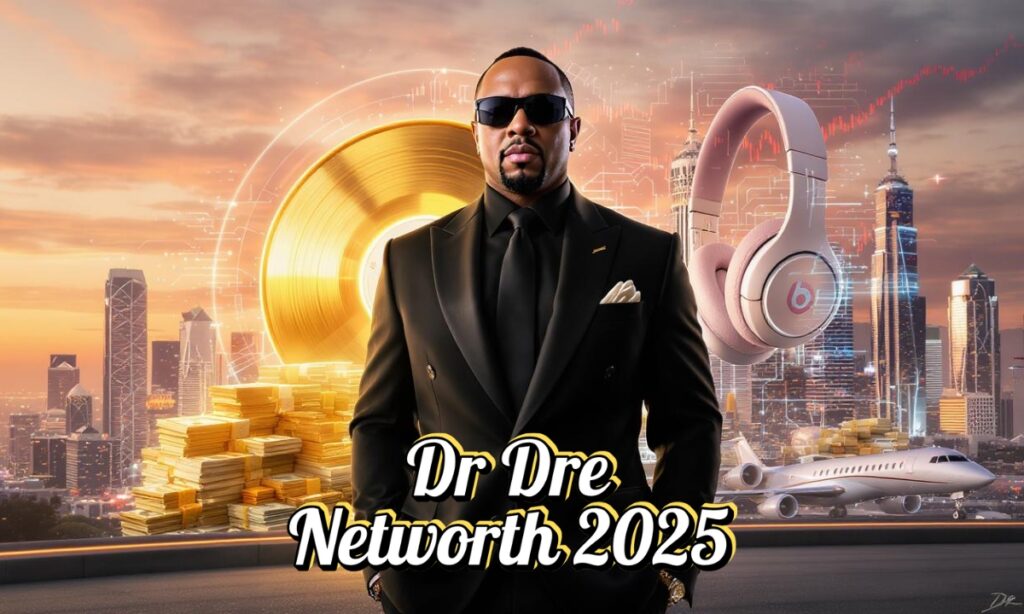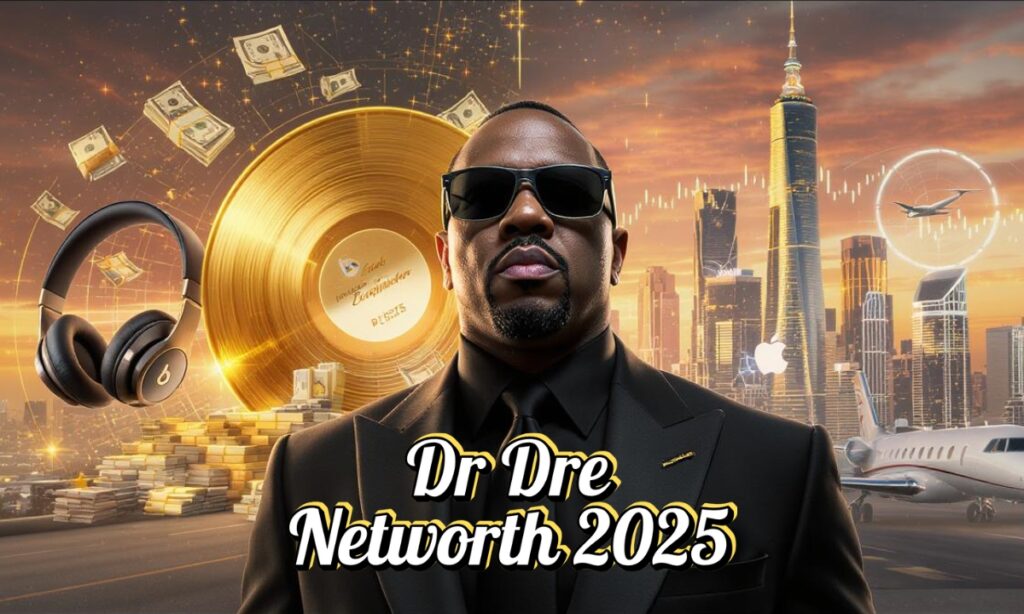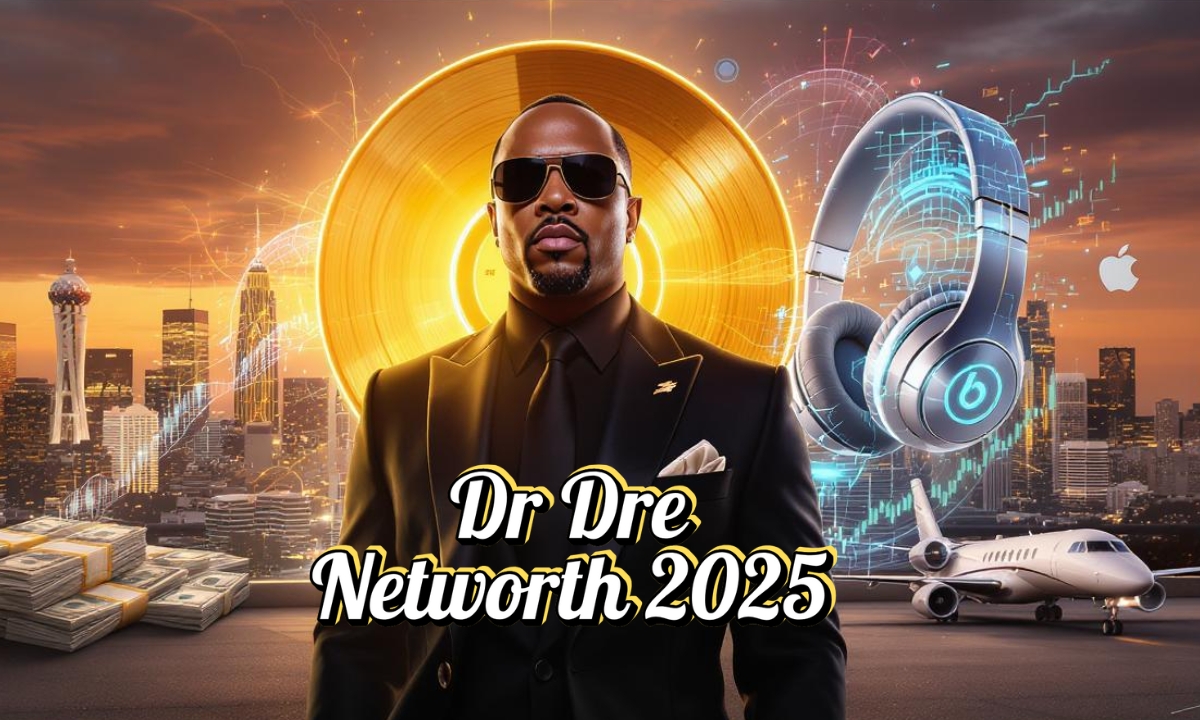When Andre Romelle Young stepped into a recording studio in Compton back in 1984, nobody could have predicted he’d become one of hip-hop’s most successful entrepreneurs. Today, Dr. Dre’s financial empire spans far beyond music production. His journey from gangsta rap pioneer to tech mogul reveals the shocking truth about building generational wealth in the entertainment industry.
Dr. Dre net worth in 2025 stands as a testament to strategic business decisions and calculated risks. While he briefly held billionaire status following the Apple acquisition, his current wealth hovers between $500-820 million. This figure represents more than just music royalties—it’s the result of decades of smart investments, brand building, and recognizing opportunities that others missed.
The story behind his billion-dollar empire isn’t just about beats and rhymes. It’s about transforming street credibility into corporate success, turning artistic vision into business ventures, and leveraging cultural influence into lasting financial power.
Dr. Dre’s Bio and Wiki
| Personal Details | Information |
| Full Name | Andre Romelle Young |
| Born | February 18, 1965 (Age 60 in 2025) |
| Birthplace | Compton, California |
| Net Worth (2025) | $500-820 million |
| Primary Wealth Sources | Music production, Beats Electronics, real estate |
| Children | 8 children |
| Marital Status | Married to Nicole Young (divorced 2021) |
Andre Romelle Young’s transformation from a kid in Compton to hip-hop royalty reads like a modern American success story. Born into a working-class family, his early exposure to music came through his mother’s record collection and the vibrant DJ culture of 1980s Los Angeles.
His Compton beginnings shaped more than just his musical style—they instilled a survival mentality that would later drive his business acumen. The harsh realities of gang violence and economic struggle motivated Young to view music not just as artistic expression, but as his ticket to a better life.
Before becoming Dr. Dre, Young worked at Northrop Grumman, an aerospace company, while pursuing his passion for music production. This experience in corporate America taught him valuable lessons about structure, professionalism, and the importance of reliable revenue streams—knowledge that would prove invaluable in his later business ventures.
Dr. Dre’s Early Career: From N.W.A. to First Millions

Humble beginnings in Compton
The streets of Compton in the 1980s weren’t exactly a breeding ground for billionaires. Young’s family struggled financially, and his neighborhood was ground zero for the crack epidemic that devastated urban communities across America. Yet these challenging circumstances became the foundation of his artistic authenticity and business drive.
His introduction to the music industry came through World Class Wreckin’ Cru, a local electro-funk group where he learned the basics of production and performance. The group’s modest success taught him crucial lessons about the music business—particularly how record labels often exploited young artists.
Key early influences included:
- DJ culture at local clubs and house parties
- Electro-funk and early hip-hop production techniques
- The entrepreneurial spirit of independent record labels
- Street-level understanding of what audiences wanted
These formative experiences shaped his approach to artist development and would later influence how he structured deals at Aftermath Entertainment.
N.W.A. earnings and royalty disputes
The formation of N.W.A. in 1987 marked Dr. Dre’s first taste of mainstream success—and his first hard lesson about music industry exploitation. Despite “Straight Outta Compton” selling over 2.5 million copies, the group members saw relatively little of the profits.
N.W.A. Financial Breakdown:
- Album sales: 2.5+ million copies
- Retail value: $25+ million
- Artist earnings: Less than $1 million total
- Dr. Dre’s share: Approximately $100,000-200,000
The shocking disparity between sales and earnings exposed the predatory nature of many record deals. Manager Jerry Heller and Eazy-E’s Ruthless Records maintained control over the group’s finances, leaving talented artists with minimal compensation for their cultural impact.
This experience taught Dr. Dre invaluable lessons about ownership, publishing rights, and the importance of controlling one’s music catalog. The financial exploitation he experienced with N.W.A. would later inform his approach to artist contracts and business partnerships.
Death Row Records and first major wealth accumulation
Dr. Dre’s partnership with Suge Knight to form Death Row Records in 1991 represented his first real opportunity to build significant wealth. Unlike his N.W.A. experience, this venture positioned him as both artist and executive, allowing him to capture value from multiple revenue streams.
“The Chronic” (1992) Financial Success:
- First-week sales: 200,000 copies
- Total sales: 5.7 million copies
- Revenue generated: $50+ million
- Dr. Dre’s earnings: $8-12 million
The album’s success proved that West Coast hip-hop could dominate national charts. More importantly, it established Dr. Dre as a bankable producer whose involvement guaranteed commercial success.
His work with Snoop Dogg on “Doggystyle” further cemented his reputation and earning power. As executive producer, he commanded substantial fees while building his network of collaborators who would later become valuable business partners.
However, the violent culture surrounding Death Row Records ultimately drove Dr. Dre away from the label. Despite leaving millions in potential earnings on the table, his departure demonstrated the strategic business decisions that would define his career—prioritizing long-term stability over short-term profits.
The Chronic to Aftermath: Building a Music Empire
Revenue from groundbreaking albums
Dr. Dre’s solo career generated substantial wealth through both artistic and business innovation. His approach to album production—combining cutting-edge technology with carefully curated collaborations—created products that delivered both critical acclaim and commercial success.
Album Revenue Analysis:
| Album | Year | Sales | Revenue | Dr. Dre’s Share |
| The Chronic | 1992 | 5.7 million | $50+ million | $8-12 million |
| 2001 | 1999 | 7.6 million | $60+ million | $25-35 million |
| Compton | 2015 | 500,000 | $5 million | $3-4 million |
The financial impact of “2001” proved particularly significant. Released through his own Aftermath Entertainment, the album allowed him to retain a much larger percentage of profits compared to his Death Row days. The album’s success also established his reputation as a hit-maker who could deliver commercial success while maintaining artistic integrity.
Streaming royalties from these albums continue generating substantial passive income. Platforms like Spotify and Apple Music have given his music catalog new life, with monthly streaming numbers in the millions generating consistent revenue streams.
Launching Aftermath Entertainment
In 1996, Dr. Dre founded Aftermath Entertainment as a joint venture with Interscope Records. This strategic business decision positioned him as both artist and executive, allowing him to develop new talent while building long-term wealth through ownership stakes.
Aftermath’s Business Model:
- 50/50 partnership with Interscope Records
- Artist development focus over quick profits
- Comprehensive production services
- Publishing and merchandising rights retention
The label’s early years proved challenging financially. Initial signings like Rakim and Group Therapy failed to generate expected returns. However, Dr. Dre’s commitment to artist development and his willingness to invest in long-term relationships eventually paid massive dividends.
His approach differed significantly from typical record label operations. Instead of signing numerous artists hoping for hits, Aftermath focused on intensive development of select talents. This strategy required higher upfront investment but generated superior returns when successful.
Discovering Eminem and 50 Cent: The financial impact
The signings of Eminem and 50 Cent transformed Aftermath Entertainment from a struggling startup into a profit-generating machine. These partnerships demonstrate how Dr. Dre’s ear for talent translated into extraordinary financial returns.
Eminem Partnership Financial Impact:
- “The Slim Shady LP” (1999): 4 million copies sold
- Dr. Dre’s production fees: $2-3 million
- Ongoing royalty streams: $500,000+ annually
- Executive producer credits: Additional $1-2 million per album
The Eminem partnership proved particularly lucrative because it established Dr. Dre as a crossover producer capable of creating mainstream hits without sacrificing street credibility. This reputation attracted other high-profile artists and commanded premium production fees.
50 Cent’s “Get Rich or Die Tryin'” Success:
- Album sales: 8.4 million copies
- Total revenue: $65+ million
- Dr. Dre’s earnings: $8-12 million
- Long-term royalty value: $15+ million
These partnerships showcased Dr. Dre’s unique ability to identify raw talent and transform it into commercial gold. His hands-on approach to artist development—providing not just beats but career guidance—created lasting relationships that continue generating revenue streams decades later.
The Beats Revolution: How Dr. Dre’s Net Worth Exploded
Creating Beats Electronics with Jimmy Iovine
The 2008 launch of Beats Electronics marked Dr. Dre’s transition from music mogul to tech entrepreneur. Partnering with Interscope Records chairman Jimmy Iovine, he identified a massive opportunity in the premium headphone market that established audio companies had ignored.
Beats Electronics Founding Details:
- Initial investment: $20 million
- Dr. Dre’s ownership: 20-25%
- Jimmy Iovine’s stake: 25-30%
- Outside investors: 45-55%
The concept emerged from Dr. Dre’s frustration with how his carefully crafted productions sounded through cheap headphones. Most consumers experienced his music through low-quality earbuds or computer speakers, missing the nuanced details that made his productions special.
Beats’ Market Strategy:
- Premium pricing ($200-$400 vs. $20-$50 competitors)
- Celebrity endorsements and cultural marketing
- Focus on bass-heavy sound signature
- Lifestyle brand positioning over technical specifications
The partnership leveraged both founders’ strengths. Iovine brought record industry connections and business acumen, while Dr. Dre provided cultural credibility and product development insight. This combination proved devastating to established audio brands that had relied on technical marketing rather than emotional connection.
Marketing strategy that revolutionized the headphone industry
Beats Electronics didn’t just sell headphones—it sold status, style, and connection to hip-hop culture. The marketing strategy brilliantly leveraged Dr. Dre’s credibility and network to create unprecedented demand for premium audio products.
Revolutionary Marketing Tactics:
- Celebrity product placement in music videos
- Strategic partnerships with athletes and entertainers
- Social media campaigns targeting younger demographics
- Retail partnerships with Apple and Best Buy
The brand’s success stemmed from understanding that headphones had become fashion accessories, not just audio technology. Young consumers wanted to display their musical taste and cultural awareness through their choice of headphones.
Celebrity Endorsement ROI:
- Investment in celebrity partnerships: $50+ million
- Brand value increase: $500+ million
- Market share growth: 0% to 64% in premium segment
- Revenue multiplication: 10x return on marketing spend
This approach transformed the entire headphone industry. Competitors scrambled to create lifestyle brands and celebrity partnerships, but Beats Electronics had already captured the cultural high ground that established its dominance.
The historic $3 billion Apple acquisition
Apple’s 2014 acquisition of Beats Electronics for $3 billion represented one of the most significant exits in entertainment history. The deal instantly transformed Dr. Dre’s net worth and validated his transition from artist to tech entrepreneur.
Acquisition Breakdown:
- Total purchase price: $3 billion
- Cash component: $2.6 billion
- Apple stock: $400 million
- Dr. Dre’s estimated payout: $500-800 million
The acquisition made Dr. Dre temporarily hip-hop’s first billionaire, though taxes and other factors reduced his actual liquid wealth. Nevertheless, the deal represented a massive validation of his business acumen and strategic vision.
Why Apple Paid Premium:
- Beats Music streaming service (pre-Apple Music)
- Premium headphone market dominance
- Cultural credibility in younger demographics
- Dr. Dre and Jimmy Iovine’s expertise
Apple’s willingness to pay such a premium reflected Beats Electronics’ success in creating emotional connections with consumers. The brand had achieved something that traditional tech companies struggled with—making hardware aspirational rather than merely functional.
The deal also secured Dr. Dre’s financial future while providing him with new opportunities within Apple’s ecosystem. His continued involvement in product development and marketing ensured ongoing revenue streams beyond the initial payout.
Dr Dre Net Worth 2025

Dr Dre Net Worth 2025 stands as a testament to three decades of strategic empire-building that transformed a Compton street kid into one of hip-hop’s wealthiest moguls. Current estimates place his wealth between $500-820 million, a figure that reflects his diversified approach to building lasting financial success.
While he briefly achieved billionaire status following the Apple acquisition of Beats Electronics, his current net worth represents a more sustainable foundation built on music royalties, real estate investments, and ongoing business ventures.
Unlike many entertainers who rely solely on performance income, Dr. Dre’s wealth stems from ownership stakes in his music catalog, Aftermath Entertainment, and strategic investments that continue generating revenue streams long after the initial work was completed. His 2025 financial position demonstrates the power of thinking beyond traditional music industry boundaries—proving that true wealth comes from building assets rather than just earning fees.
Current Income Streams Contributing to Dr. Dre’s Net Worth
Music royalties and streaming revenue
Dr. Dre’s music catalog continues generating substantial passive income through multiple channels. Digital streaming platforms have breathed new life into his classic albums, while his production credits on other artists’ work create ongoing royalty payments.
Current Streaming Performance:
- Monthly Spotify streams: 15+ million
- Apple Music plays: 10+ million monthly
- YouTube views: 2+ billion annually
- Estimated annual streaming revenue: $2-3 million
His catalog’s enduring popularity demonstrates the long-term value of creating culturally significant music. Songs like “Still D.R.E.” and “Nuthin’ But a ‘G’ Thang” maintain strong streaming numbers nearly three decades after their release.
Publishing and Sync Licensing:
- Film and TV sync fees: $500,000+ annually
- Commercial licensing: $200,000+ per year
- International royalty collection: $1+ million annually
- Mechanical royalties: $300,000+ yearly
The strategic business decisions made during his career—particularly retaining publishing rights wherever possible—continue paying dividends. His foresight in securing ownership stakes in his work creates lasting wealth that benefits his family for generations.
Real estate portfolio worth $80+ million
Dr. Dre’s real estate portfolio represents both luxury lifestyle choices and shrewd investment strategy. His properties span California’s most exclusive neighborhoods, providing both personal enjoyment and wealth preservation.
Major Property Holdings:
| Property | Location | Purchase Price | Current Value |
| Brentwood Mansion | Los Angeles | $40 million | $50+ million |
| Malibu Beach House | Malibu | $4.8 million | $8+ million |
| Woodland Hills Estate | San Fernando Valley | $2.4 million | $4+ million |
| Hollywood Hills House | Hollywood | $15 million | $20+ million |
His 2014 purchase of Tom Brady and Gisele Bundchen’s Brentwood mansion for $40 million demonstrated his commitment to ultra-luxury real estate. The 18,000-square-foot property features amenities that reflect his success while serving as a hedge against inflation.
Real Estate Investment Strategy:
- Focus on California luxury markets
- Properties in exclusive, celebrity-preferred neighborhoods
- Long-term appreciation over rental income
- Diversification across property types
The real estate portfolio provides stability and growth potential that complements his more volatile entertainment industry revenue streams. California’s consistently strong luxury market ensures these investments maintain value while offering potential for significant appreciation.
Recent business ventures and investments
Dr. Dre’s current business ventures demonstrate his continued evolution as an entrepreneur. His investment strategy focuses on industries where his expertise and network provide competitive advantages.
Current Investment Focus Areas:
- Cannabis industry startups
- Music technology companies
- Entertainment production ventures
- Venture capital partnerships
His involvement in cannabis businesses reflects both personal interest and market opportunity. California’s legal cannabis market offers significant growth potential, and his cultural credibility provides marketing advantages for partner companies.
Technology Investments:
- Music production software companies
- Streaming platform startups
- Audio technology development
- Artist development platforms
These investments leverage his deep understanding of music creation and consumption trends. His ability to identify emerging technologies that could impact the industry provides valuable insights for investment decisions.
Media Production Ventures:
- Documentary production companies
- Podcast networks
- Digital content creation
- Educational program development
His recent work on projects like “The Defiant Ones” documentary series demonstrates his interest in storytelling beyond music. These ventures create new revenue streams while building his legacy in entertainment history.
Conclusion
Dr. Dre net worth in 2025 represents more than just accumulated wealth—it’s a blueprint for artistic and entrepreneurial success. His journey from Compton beginnings to building a billion-dollar empire demonstrates the power of strategic vision, calculated risk-taking, and never losing sight of long-term goals.
The shocking truth behind his financial empire isn’t just about talent or luck. It’s about consistently making strategic business decisions that prioritized ownership, relationships, and cultural relevance over short-term profits. From his early experiences with N.W.A. to the Beats Electronics acquisition, every phase of his career taught valuable lessons about building sustainable wealth.
Key Wealth-Building Principles:
- Ownership over everything: Retaining rights to music, businesses, and investments
- Cultural credibility: Leveraging authenticity to build lasting brands
- Strategic partnerships: Choosing collaborators who complement strengths
- Long-term thinking: Prioritizing sustainable growth over quick profits
- Diversification: Building revenue streams across multiple industries
His music catalog, real estate portfolio, and ongoing business ventures continue generating substantial returns while providing the foundation for generational wealth. The Aftermath Entertainment roster, Grammy Awards, and cultural impact ensure his influence extends far beyond personal financial success.
Dr. Dre’s empire demonstrates that artists can transcend their original medium to become true entrepreneurs. His success in the premium headphone market, real estate investments, and technology ventures proves that creative vision and business acumen can create lasting wealth in any industry.
The legacy extends beyond personal achievement. His approach to artist development, brand building, and strategic business decisions has influenced countless musicians and entrepreneurs. Young artists now understand that building wealth requires thinking beyond album sales and concert revenues.
Looking ahead, Dr. Dre’s net worth will likely continue growing through his diversified investments and ongoing cultural relevance. His story proves that with vision, determination, and strategic thinking, it’s possible to build an empire that transcends any single industry or artistic medium.
The shocking truth? Dr. Dre’s billion-dollar empire wasn’t built on beats alone—it was constructed through decades of smart decisions, strategic partnerships, and never forgetting the lessons learned on the streets of Compton. That’s the real blueprint for lasting success in the modern entertainment industry.
Dr Dre’s shocking $500-820M net worth in 2025 revealed: From Compton to billionaire through Beats, music empire & smart investments.

Admin: Jiya Pari
Jiya Pari is the talented admin of Cutegirlphoto.info, bringing 5 years of experience in blogging and content creation. She manages the site with creativity and care, ensuring a fun and engaging experience for all visitors.





